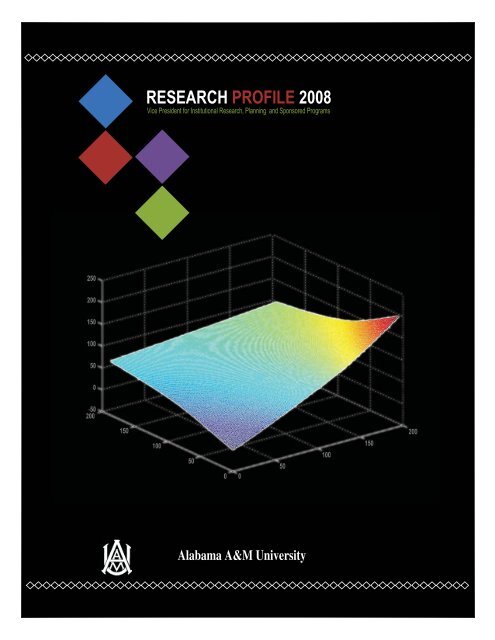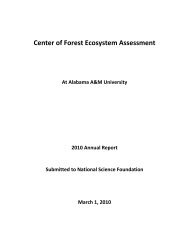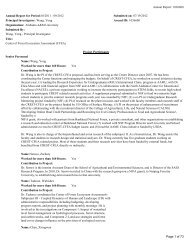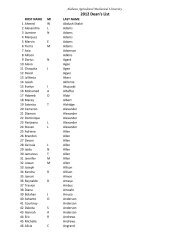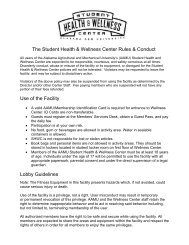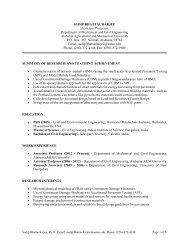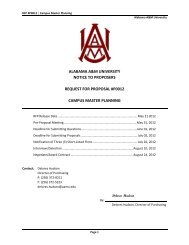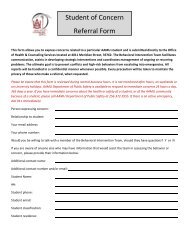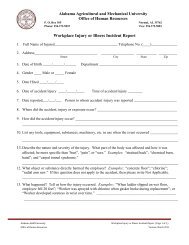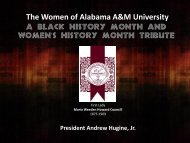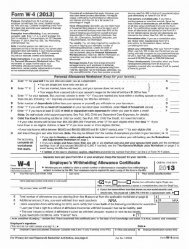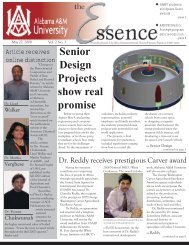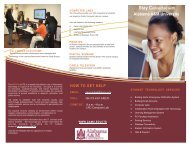research profile 2008 - Alabama A&M University
research profile 2008 - Alabama A&M University
research profile 2008 - Alabama A&M University
You also want an ePaper? Increase the reach of your titles
YUMPU automatically turns print PDFs into web optimized ePapers that Google loves.
RESEARCH PROFILE <strong>2008</strong><br />
Vice President for Institutional Research, Planning and Sponsored Programs<br />
<strong>Alabama</strong> A&M <strong>University</strong>
Overview<br />
In fi scal year <strong>2008</strong> (October 1, 2007 to September 30, <strong>2008</strong>),<br />
<strong>Alabama</strong> A&M <strong>University</strong> made tremendous progress in its<br />
<strong>research</strong> programs as proposed and executed by our faculty<br />
and supported by our <strong>research</strong> administrative units. Just as in<br />
past years, our faculty, scientists, scholars and students worked<br />
closely in interdisciplinary teams, along with partners in industry<br />
and the community, to approach critical issues from many different<br />
viewpoints. The record $47.2 million in <strong>research</strong> funding for this<br />
period, a 48-percent increase over the previous reporting cycle, is<br />
a refl ection of their hard work.<br />
1
While funding levels for sponsored projects provide one clear indicator of the<br />
vitality of the <strong>University</strong>’s <strong>research</strong> and enterprise, the distinction of our faculty is also<br />
evidenced by membership in prestigious national academies and societies, awards<br />
from preeminent grant and fellowship programs, citations and other recognition and<br />
honors. For instance, Dr. Teferi Tsegaye, a soil physicist and chair of the Department of<br />
Natural Resources and Environmental Sciences, was selected to serve on a national,<br />
30-member advisory committee to advise the U.S. government on environmental<br />
policy issues impacting farms, ranches and rural communities.<br />
In collaborative and interdisciplinary efforts, Dr. Kaveh<br />
Heidary, associate professor of Electrical Engineering in<br />
the School of Engineering and Technology, is leading a<br />
team of scientists from his school and the School of Arts<br />
and Sciences in a $783,000 U.S. Department of<br />
Defense-funded program to investigate, develop<br />
and integrate two nanotechnology-enhanced<br />
cooling mechanisms for applications in<br />
electromagnetic detection systems<br />
such as infrared focal pale arrays.<br />
Also in the School of Arts and Sciences, Dr.<br />
Razi Hassan, associate professor of Chemistry,<br />
as the principal investigator working with a coinvestigator<br />
from the School of Education, won<br />
a $2 million grant from the U.S. Department of Health<br />
and Human Services to re-establish a Health Career<br />
Opportunity Program (HCOP) at AAMU.<br />
In international partnership, Dr. Mary Spor, professor of Reading/<br />
Literacy, also in the School of Education, is leading a three-year, $5.5 million<br />
collaborative program with the Ethiopian Ministry of Education and the U.S.<br />
Agency for International Development (USAID) to develop English textbooks<br />
and teacher’s manuals for grades 1, 2, 6, 7 and 8. The effort, named the<br />
Textbooks and Learning Materials Program, is part of USAID’s Africa<br />
Education Initiative to develop and distribute quality and culturally based<br />
textbooks and learning materials for schools in Sub-Sahara Africa. Already,<br />
grades 1, 6, 7 and 8 English textbooks and teacher’s guides are in the hands of<br />
over 3 million students and their teachers in 11 regions of Ethiopia.<br />
<strong>Alabama</strong> EPSCoR<br />
Giving additional impetus to our collaborative effort, AAMU received the distinction of being the lead<br />
institution for the state’s EPSCoR (Experimental Program to Stimulate Competitive Research) with a<br />
fi ve-year, $15 million grant from the NSF. The fund, intended to continue the work of four Centers of<br />
Excellence, will help to build <strong>Alabama</strong>’s ability to participate in, conduct and compete for nanotechnology<br />
<strong>research</strong>. AAMU will house the Center for Interdisciplinary Discovery via Engineered Nanofabrication<br />
(CIDEN). The other centers will be housed at Tuskegee <strong>University</strong>, Auburn <strong>University</strong> and the <strong>University</strong><br />
of <strong>Alabama</strong> at Birmingham.<br />
2
Sponsored Programs<br />
During the year under review,<br />
we initiated open discussions with<br />
faculty and other administrators to<br />
develop a more strategic direction<br />
for <strong>research</strong>, as well as to develop<br />
policies to guide the conduct of<br />
<strong>research</strong> on campus, facilitate<br />
and promote technology transfer<br />
and economic development, and<br />
a service-oriented administrative<br />
infrastructure to serve the faculty<br />
and staff involved in <strong>research</strong>.<br />
Also, more faculty members took<br />
advantage of training workshops,<br />
seminars and other incentives to<br />
hone their skills in identifying and<br />
seeking supplemental funding to<br />
address the growing demand for<br />
quality <strong>research</strong> and innovation.<br />
In addition to already available<br />
resources in IRPSP, which<br />
developed a one-on-one needs<br />
assessment approach to training<br />
in the various schools, the offi ce<br />
hosted nationally recognized<br />
trainers from funding agencies such<br />
as the National Institutes of Health<br />
(NIH) and the National Science<br />
Foundation (NSF) to conduct<br />
training in how to be successful<br />
grant writers.<br />
As a result, our department<br />
saw a marked increase in faculty<br />
participation in grant writing. One<br />
hundred and thirty proposals were<br />
submitted in the last funding cycle<br />
(Sept. 2007 – October <strong>2008</strong>),<br />
accounting for participation by 98<br />
faculty members including PIs and<br />
co-PIs. This increased participation<br />
accounts for the $47.2 million<br />
reported earlier.<br />
3
As the economic downturn<br />
hit home with budget cuts and<br />
reductions in key services, the<br />
<strong>University</strong> looked in other areas<br />
to fi ll potential gaps that could<br />
negatively impact its <strong>research</strong><br />
and development base. Hence,<br />
funding, such as the intake for<br />
this reporting cycle, is impacting<br />
areas such as salaries, purchase<br />
of new equipment, community<br />
outreach, education in food<br />
technology for small farmers, and<br />
many more. The charts on these<br />
pages indicate awards received<br />
by way of function, school and<br />
type. Indicated in the charts also<br />
are the sources of the funds.<br />
AL<br />
S<br />
4
Research Institute<br />
In addition to our various units, the <strong>Alabama</strong> A&M Research Institute<br />
(AAMURI) recorded a number of achievements in 2007/<strong>2008</strong>. For the ninth<br />
year in a row, the Institute attracted major federal and private <strong>research</strong> and<br />
development agencies to its annual SBIR/STTR HBCU/MI conference to<br />
afford participants the opportunity for partnerships among representatives<br />
of small businesses in the Tennessee Valley. This yearly gathering has been<br />
largely responsible for a marked increase in the number of funded SBIR<br />
and STTR proposals. Also for the sixth consecutive year, AAMURI received<br />
the prestigious Nun-Perry Award at the annual U.S. Department of Defense<br />
Mentor-Protégé Conference. The Institute was prominently featured in The<br />
Huntsville R&D Report as a “Can do it conduit” for <strong>research</strong> and development<br />
in the region. During the past year, AAMURI doubled the number of graduate<br />
and undergraduate students supported by the Institute who are working at<br />
various schools, corporations and R&D centers across the nation.<br />
Institutional Research and Planning<br />
In 2007/<strong>2008</strong>, the Offi ce of Institutional Research and Planning<br />
(OIRP) met all of the state and federally mandated reporting requirements.<br />
The offi ce supported NCAA and ABET data needs, responded to SACSdriven<br />
data requests, and many other internal requests. With respect<br />
to its role, OIRP serves as a center for the gathering, analysis, and<br />
dissemination of institutional information and data. Additionally, the offi ce<br />
is responsible for developing routine and ad hoc reports in response to<br />
both internal and external requests from state and government regulatory<br />
bodies, accrediting agencies, professional associations, and other higher<br />
education institutions.<br />
In August of <strong>2008</strong>, OIRP began transitioning to administering<br />
surveys electronically. This new enhancement is in keeping with the<br />
<strong>University</strong>’s move toward increasing the use of electronic processes to<br />
improve operational effi ciencies and reducing costs. As a result, the offi ce<br />
reports that it is saving nearly $10,000 annually by administering surveys<br />
online.<br />
5
Other achievements/marketing<br />
Among other noted achievements, IRPSP has updated its online presence to more clearly<br />
attract visitors to its programs and services. Grant seekers now have a new source that provides<br />
guidance in answering key questions about putting a proposal together. The new Principal<br />
Investigator’s Guide gives answers to FAQs, provides guidance and direction for proposal<br />
development and post-award grant management activities, and provides insights on agency<br />
regulations, policies, compliance issues, etc.<br />
Considering that information about the <strong>University</strong>’s <strong>research</strong> endeavors was not being<br />
adequately filtered to the public and the community, IRPSP put into place a number of<br />
outlets as marketing tools to provide wider visibility about the work going on in R&D<br />
at the <strong>University</strong>. In October 2007, IRPSP launched The Essence, a bi-weekly<br />
online publication to better connect students, faculty and staff with <strong>research</strong><br />
activities on campus. Armed with the mission of timely communication, The<br />
Essence provides the <strong>University</strong> family and clients with current and noteworthy<br />
happenings in <strong>research</strong> in an easily accessible and manageable format.<br />
IRPSP also revised the <strong>University</strong>’s Capabilities Statement to refl ect new<br />
endeavors and innovations. The 18-page document, Innovation, packaged<br />
in a glossy, 11x17 folder with pocket for handouts, is in circulation. Also, IRPSP<br />
has launched the <strong>University</strong>’s fi rst national <strong>research</strong> magazine, AAMU<strong>research</strong>,<br />
whose focus is to pinpoint <strong>research</strong> activities that distinguish AAMU, build on our<br />
unique strengths, and that involve, educate and inspire our students, the community<br />
and other stakeholders. Also, with an overwhelming response to its “Call for Paper” of a<br />
year ago, IRPSP hopes to launch the <strong>University</strong>’s fi rst <strong>research</strong> journal in late 2009.<br />
With achievements such as these, and a continued emphasis on collaborations, strong<br />
strategic focus on interdisciplinary <strong>research</strong>, teaching and student mentoring, we are glad to<br />
report that our <strong>research</strong> operations are much stronger. Our goal is to continue the upward spiral<br />
in excellence and innovation.<br />
Research strengths at AAMU include biofuel production and its added value, dietary<br />
chemoprevention of colon cancer, global climate change studies, bioinformatics, food<br />
and fi ber production, medicinal crops, water resource management, remote sensing/GIS<br />
application, plant biotechnology, wetland restoration and analysis, health disparity,<br />
genetics, biofi lms, materials science (particularly nanomaterials and composites<br />
<strong>research</strong>), laser chemistry, sensor/actuator science and technology, air<br />
pollution, computational studies of poly-nitrogenous molecules, nonlinear<br />
optical materials, Czochralaski crystal growth from melt, space sciences,<br />
optics, bio and chemical sensors, spectroscopy/interferometry analysis,<br />
computational fl uid dynamics, environmental engineering, geotechnical<br />
engineering, transportation engineering, structural engineering,<br />
microelectronics, high performance computing, pattern recognition,<br />
electromagnetics, and antennas and communications. We are also<br />
versed and recognized for scholarly and creative achievements in many<br />
areas of the arts and humanities, including teacher education, reading/<br />
literacy, philosophy, counseling, art and music. Our business school, in addition to<br />
its well recognized MBA program, is also well known for its management education<br />
that promotes the development of students’ potentials as managers, entrepreneurs,<br />
leaders, productive employees and socially responsible individuals.<br />
6
ALABAMA A&M UNIVERSITY<br />
Offi ce of Institutional Research, Planning<br />
and Sponsored Programs (IRPSP)<br />
P.O. Box 411<br />
Normal, <strong>Alabama</strong> 35762<br />
Centers of Excellence<br />
School of Agricultural and Environmental Sciences (256) 372-5781<br />
• Center of Excellence for Watershed Management<br />
• Center of Excellence in Forestry<br />
• Center for Urban and Rural Research<br />
• CREST NSF Center<br />
• Geospatial Data Analysis Center for Forecasting Drought and Flood<br />
and Expansion of the <strong>Alabama</strong> Mesonet (ALMNet)<br />
• Small Farms Resource Center<br />
• Teaching Laboratory/Planning Studio<br />
School of Arts and Sciences (256) 372-5300<br />
• Center for Biomedical, Behavioral and Environmental Health Research (CBR)<br />
• Center for Interdisciplinary Discovery via Engineering Nanofabrication (CIDEN)<br />
• Center for Learning, Teaching and Research in Nanoscale Science and Technology (CLTR)<br />
• Center for Social Work Development and Research<br />
• Howard J. Foster Center for Irradiation of Materials (CIM)<br />
School of Business (256) 372-5092<br />
• Center for Disadvantaged Business Enterprise (DBE)<br />
• Center for Entrepreneurship and Economic Development (CEED)<br />
• Small Business Development Center (SBDC)<br />
School of Engineering and Technology (256) 372-5560<br />
• Center of Excellence in Integrated Sensor Systems<br />
Office of Academic Affairs (256) 372-5275<br />
• Center of Excellence in Teaching and Learning (CETL)<br />
ALABAMA A&M UNIVERSITY<br />
Dr. Andrew Hugine, Jr., President<br />
Dr. Teresa Merriweather Orok<br />
Vice President for Institutional Research, Planning and Sponsored Programs (IRPSP)<br />
Research is a major focus of <strong>Alabama</strong> A&M <strong>University</strong>. Visit us on the web at www.aamu.edu or see our <strong>research</strong> magazine,<br />
AAMU<strong>research</strong>, at www.aamu.edu/irpsp/publications.aspx.<br />
Research Profi le is published by the Offi ce of the V.P. for IRPSP. For copies, call 256-372-5675 or email irpsp@aamu.edu.<br />
Editor: Emmanuel Freeman. Designer: Torin Malone. Printing: White Tiger, Huntsville, Ala.


